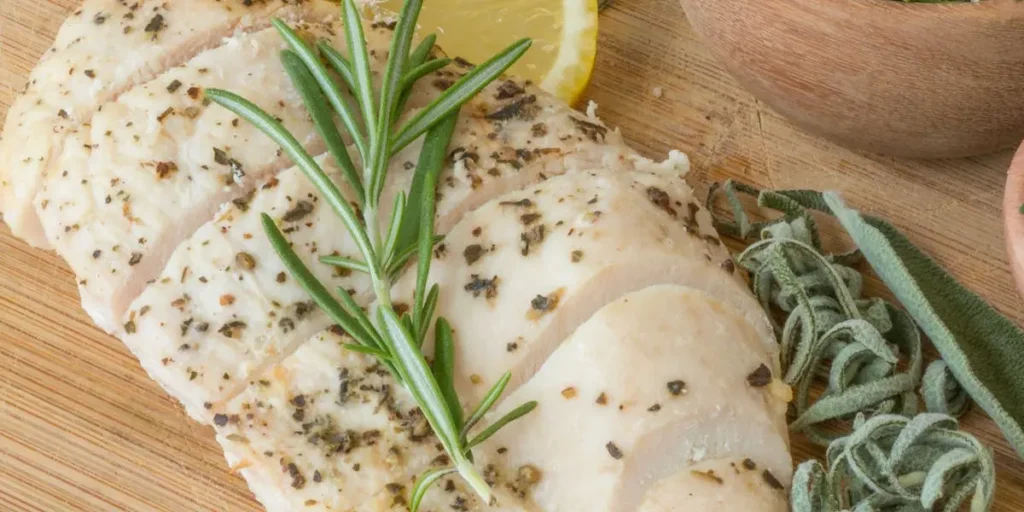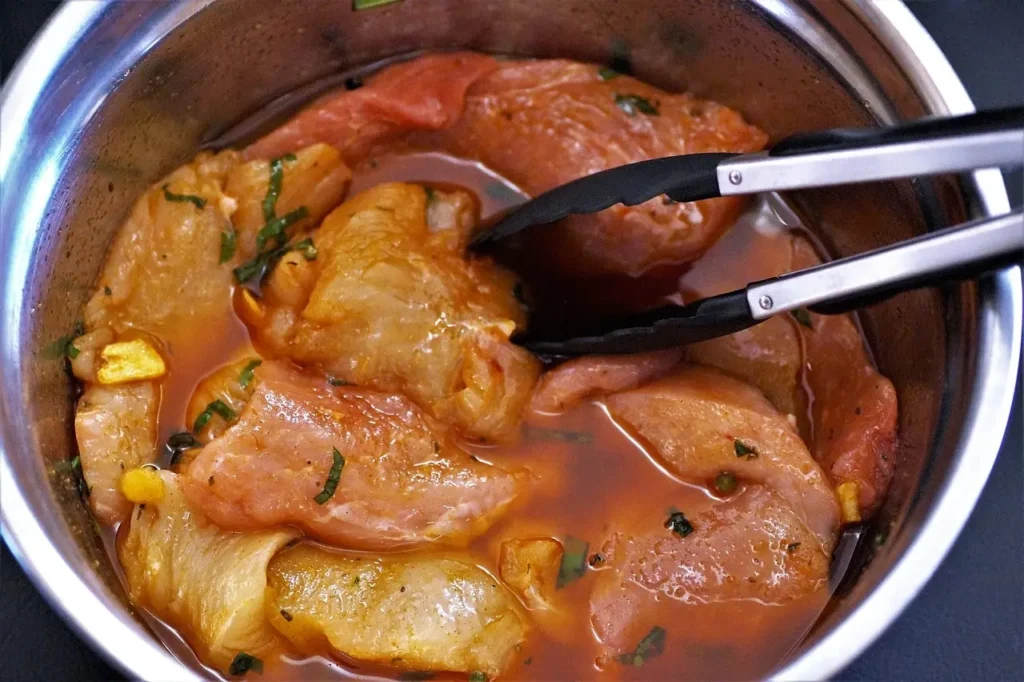Introduction to Healthy Chicken Cooking
Welcome to our comprehensive guide on healthy chicken cooking. In this article, we delve into the art of preparing chicken in a way that maximizes both flavor and health benefits. Chicken is a beloved ingredient in kitchens worldwide, prized for its versatility, flavor, and nutritional value. However, the health benefits of chicken can be significantly influenced by the way it’s cooked. This article aims to explore the best and healthiest ways to cook chicken, ensuring you maximize its nutritional potential while enjoying delicious meals.
Importance of Cooking Method in Nutritional Value
The method you choose for healthy chicken cooking can significantly impact the nutritional value of the chicken, affecting protein content, vitamin retention, and overall health benefits.
- Impact on Health and Nutrition
- The cooking method can greatly affect the chicken’s nutritional value, including its protein content, vitamin retention, and overall health benefits.
- Certain cooking techniques, especially those involving high temperatures or direct flame, can lead to the formation of harmful compounds like heterocyclic amines (HCAs) and polycyclic aromatic hydrocarbons (PAHs).
- Conversely, cooking methods that use lower temperatures or moist heat can help preserve the chicken’s nutrients and reduce the formation of these harmful compounds.
- Balancing Flavor and Nutrition
- While taste is a significant factor in choosing a cooking method, it’s essential to balance flavor with health considerations.
- Techniques like marinating, using herbs and spices, and choosing the right cooking method can enhance flavor without compromising nutritional value.
- However, it’s crucial to note that common practices like checking the color of the meat, though widely used, may not be sufficient for ensuring safety. A comprehensive study by PubMed Central highlights that such methods do not guarantee the reduction of harmful pathogens to safe levels.
Overview of Common Cooking Methods and Their Impact
- A Spectrum of Techniques
- From grilling and frying to steaming and baking, each cooking method has its unique impact on the chicken’s final nutritional profile.
- High-heat methods like frying and grilling can add crispness and flavor but may also increase the risk of harmful compound formation.
- Gentler methods like steaming and poaching preserve moisture and nutrients but may require additional flavoring techniques to enhance taste.
- Choosing the Right Method
- The choice of cooking method can depend on the cut of chicken, the desired flavor profile, and specific dietary needs.
- For instance, breast meat, being leaner, might benefit from moist cooking methods to retain its tenderness, while darker cuts can withstand higher heat.
In the following sections, we will delve into the healthiest cooking methods for chicken, explore cooking techniques to avoid for health reasons, and discuss the nutritional benefits of chicken. This comprehensive approach will provide you with the knowledge to cook chicken in ways that are both delicious and nutritious.
Exploring the Healthiest Cooking Methods for Chicken
Let’s explore the most effective techniques in healthy chicken cooking that ensure both taste and nutrition are optimized. Cooking chicken healthily is not just about avoiding harmful compounds; it’s also about preserving its rich nutritional profile. Let’s delve deeper into the four healthiest cooking methods for chicken, exploring their unique benefits and techniques.
Sous Vide Cooking
- Benefits and Techniques
- Sous vide offers precise temperature control, ensuring the chicken is cooked evenly without overcooking.
- This method involves sealing chicken in a vacuum-sealed bag, which locks in flavors and juices, enhancing the taste while maintaining nutritional value.
- Cooking temperatures typically range from 140°F to 160°F, significantly lower than grilling or frying, thus reducing the formation of harmful HAAs and PAHs.
- For an in-depth understanding of sous vide cooking and its benefits, explore resources like Harvard Health’s guide to healthy cooking.
Steaming Chicken
- How It Preserves Nutrients
- Steaming is a moist-heat cooking method that preserves the integrity of chicken’s proteins and vitamins, such as B6 and niacin.
- It requires no oil or fat, making it a heart-healthy choice.
- The gentle cooking process ensures that the chicken remains tender and moist, ideal for those who are health-conscious.
- Steaming can be enhanced with herbs and spices in the steaming water or directly on the chicken, infusing it with additional flavors without adding calories.
Pressure Cooking
- Advantages Over Traditional Cooking
- Pressure cooking uses steam under high pressure, cooking chicken faster and at higher temperatures, but for a shorter duration.
- This method is excellent for making stews and soups, as it extracts flavors and nutrients from the chicken and infuses them into the broth.
- It’s particularly effective in breaking down tougher cuts of chicken, making them tender and easier to digest.
- For safe cooking practices, including pressure cooking, refer to the USDA guidelines.
Microwaving
- Convenience and Health Considerations
- Microwaving is not just about convenience; it’s also about quick, even cooking that can preserve nutrients effectively.
- It’s ideal for reheating cooked chicken or preparing simple chicken dishes quickly.
- To ensure even cooking, arrange chicken pieces uniformly and turn them midway during cooking.
- While it may not brown the chicken like other methods, it significantly reduces the risk of forming harmful compounds.
When adopting methods like Sous Vide, Steaming, Pressure Cooking, and Microwaving, it’s important to refer to Food Safety and Inspection Service guidelines and FoodSafety.gov’s Safe Minimum Internal Temperatures Chart to ensure that the chicken reaches safe internal temperatures, thus mitigating the risk of pathogens
Each of these methods offers a unique set of benefits, making them ideal for health-conscious individuals who don’t want to compromise on taste or nutrition. In the next part, we will explore cooking methods that should be avoided due to their potential health risks.
Cooking Methods to Avoid
While exploring healthy chicken cooking, it’s also important to be aware of certain cooking methods that might be detrimental to your health.
High-Temperature Cooking Risks
- Grilling, Barbecuing, and Other Methods
- Grilling and barbecuing often involve cooking at temperatures above 300°F, which can lead to the formation of heterocyclic amines (HCAs) and polycyclic aromatic hydrocarbons (PAHs).
- These methods can cause charring, which not only alters the flavor but also increases the risk of these harmful compounds.
- While occasional grilling might be safe, regular consumption of charred or overcooked chicken can pose long-term health risks.
- To minimize these risks, avoid direct exposure of chicken to open flames and consider pre-cooking it partially before grilling.
The Dangers of HCAs and PAHs
- Understanding Carcinogenic Compounds
- HCAs form when amino acids, sugars, and creatine react at high temperatures, typically during frying or grilling.
- PAHs are created when fat and juices from chicken drip onto a hot surface or open fire, creating smoke that adheres to the surface of the meat.
- Both HCAs and PAHs have been linked to an increased risk of cancer in some studies, emphasizing the need for caution with these cooking methods.
- Marinating chicken can reduce HCA formation, and using leaner cuts can minimize PAHs since they have less fat to drip and create smoke.
Alternative Cooking Techniques
- Safer Options for Flavorful Chicken
- If you enjoy the flavor that grilling or barbecuing imparts, consider using a grill pan on the stove, which can provide similar taste without the direct flame.
- Baking or roasting chicken in the oven can also yield delicious results while being much safer in terms of HCA and PAH production.
- Experimenting with herbs, spices, and marinades can add a variety of flavors to chicken cooked using these safer methods.
Understanding the risks associated with certain cooking methods is key to making informed decisions about your diet. By choosing healthier alternatives, you can enjoy delicious chicken dishes without compromising your health.
In the next section, we’ll delve into the nutritional benefits of chicken, highlighting why it’s a valuable addition to your diet and how to maximize its health benefits through proper cooking techniques.
Nutritional Benefits of Chicken
Chicken is a highly regarded source of nutrition, offering a range of health benefits. It’s a versatile protein that can be a staple in a balanced diet when cooked properly. Let’s explore the nutritional profile of chicken in more detail and understand why it’s such a valuable food.
Protein and Essential Minerals
- Rich Source of High-Quality Protein
- Chicken is an excellent source of lean, high-quality protein, essential for muscle building, repair, and overall bodily functions.
- It provides all the essential amino acids, making it a complete protein source, crucial for those who are active, elderly, or recovering from illness.
- Loaded with Vital Minerals
- Chicken is a good source of essential minerals like iron, which is vital for forming red blood cells and transporting oxygen around the body.
- It also contains zinc, crucial for immune function and selenium, an antioxidant that helps protect cells from damage.
- These minerals are particularly abundant in dark meat cuts like thighs and drumsticks.
Vitamins and Other Nutrients in Chicken
- B Vitamins for Energy and Metabolism
- Chicken is rich in various B vitamins, particularly B6 and B12, which are essential for energy production, brain health, and maintaining healthy blood cells.
- Regular consumption of chicken can contribute to improved nervous system function and can help prevent issues like fatigue and anemia.
- Low in Saturated Fat
- Chicken, especially the breast portion, is low in saturated fat compared to many red meats, making it a healthier choice for maintaining heart health.
- Opting for skinless chicken is a way to reduce fat intake further, particularly saturated fat, which is higher in the skin.
- Versatility in Diet
- Chicken’s mild flavor and texture make it an excellent protein choice for a variety of cuisines and dietary preferences.
- It can be easily incorporated into salads, soups, stews, and grilled dishes, making it a versatile component in meal planning.
Understanding the nutritional benefits of chicken highlights the importance of cooking it in ways that preserve these nutrients. By choosing healthier cooking methods, you can enjoy the full range of benefits chicken offers, making it a valuable part of a nutritious diet.
In the next section, we will address some frequently asked questions about cooking chicken, providing you with a comprehensive guide to making the most out of this versatile and nutritious food.
Frequently Asked Questions on Healthy Chicken Cooking
In this section, we address some common queries related to cooking chicken in a healthy way. These FAQs aim to clarify doubts and provide practical tips for incorporating healthy chicken cooking methods into your daily routine.
Best Practices for Cooking Chicken
- What is the safest internal temperature for cooked chicken?
- The USDA recommends cooking chicken to an internal temperature of 165°F (73.9°C) to ensure it’s safe to eat. Using a meat thermometer can help you achieve this safely.
- How can I retain the moisture in chicken when cooking?
- Methods like sous vide and steaming are excellent for retaining moisture. Marinating chicken before cooking can also help keep it juicy.
- Is it healthy to cook chicken with the skin on?
- Cooking chicken with the skin can add extra fat and calories. However, it can be removed before eating to enjoy the flavor without the added fat.
Addressing Common Health Concerns
- Does cooking method affect the protein content of chicken?
- Most cooking methods do not significantly affect the protein content. However, overcooking can make chicken tough and less enjoyable to eat.
- Are there any risks associated with microwaving chicken?
- When done correctly, microwaving is a safe and healthy way to cook chicken. Ensure the chicken is cooked evenly and reaches the recommended internal temperature.
- Can I make grilled chicken healthier?
- If you prefer grilling, try to avoid charring the meat and use marinades to reduce the formation of HCAs and PAHs. Grilling at lower temperatures and keeping the meat away from open flames can also help.
This comprehensive guide to cooking chicken healthily should provide you with the knowledge and confidence to make healthier choices in your kitchen. By understanding the best practices and addressing common concerns, you can enjoy delicious and nutritious chicken dishes without compromising on health.
In the next and final part of our article, we will wrap up with concluding thoughts and final recommendations for health-conscious cooks.
Conclusion and Recommendations
In conclusion, the way we cook chicken significantly impacts its nutritional value and our health. By choosing methods like sous vide, steaming, pressure cooking, and microwaving, we can enjoy chicken’s rich nutritional benefits while minimizing health risks. Remember to avoid high-temperature cooking methods that can produce harmful compounds, and always aim for the right internal temperature to ensure food safety.
Summary of Best Practices
- Opt for cooking methods that preserve moisture and nutrients.
- Be mindful of the internal temperature for safe consumption.
- Balance flavor and health by being cautious with high-heat methods.
Final Recommendations for Health-Conscious Cooks
- Experiment with different healthy cooking methods to find what works best for you.
- Always prioritize safety and nutrition in your cooking choices.
- Enjoy the versatility and benefits of chicken as part of a balanced diet.
By following these guidelines, you can make the most out of your chicken dishes, ensuring they are not only delicious but also a healthy choice for you and your family.


